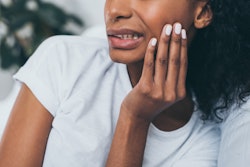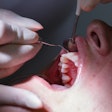
Patients want to receive the long-acting local anesthetic liposomal bupivacaine to help manage pain after third-molar surgery, but few are willing to pay for it themselves, according to study findings published earlier this month in the Journal of Oral and Maxillofacial Surgery.
In addition to the cost, there was a link to patients’ interest in the use of liposomal bupivacaine (LB) for third-molar extractions and concern about the addictive potential of opioids and previous use of a prescribed opioid medication, the authors wrote.
“The majority of subjects were interested in LB as an adjunctive medication for postoperative analgesia after third molar extractions but were not willing to pay for the medication at its current price,” wrote the authors, led by Dr. Joli Chou, an associate professor in the department of oral and maxillofacial surgery at Thomas Jefferson University in Philadelphia (J Oral Maxillofac Surg, August 9, 2023).
Pain relief without opioids
Past research has shown that patients who were prescribed opioids after low-pain surgery have a 44% increased risk of long-term opioid use. Also, the use of opioids for pain after surgery has played a major role in the current opioid crisis.
Long-lasting anesthetics like LB can be used for postprocedure pain relief without the need for opioids. In 2011, the U.S. Food and Drug Administration approved LB to be locally administered in a single dose to a surgical site for pain relief after a procedure.
Though it controls pain well, it is expensive. Currently, LB is sold in vials for $215 per 10 mL dose and $365 per 20 mL dose. It is often not covered by dental or medical insurance plans when used for postoperative pain management in third-molar extractions, the authors wrote.
To determine patient interest in using LB as an alternative to opioid pain medication following wisdom tooth surgery, 183 patients age 17 and older responded to a questionnaire-based study. Patients included in the study visited the Thomas Jefferson University Oral and Maxillofacial Surgery Clinic for third-molar extraction from May 2019 to January 2020, according to the study.
Of the respondents, 76% were interested in nonopioid alternative, but only 10% of participants were able or willing to pay for LB at its current cost irrespective of interest. Additionally, of those interested in bupivacaine, 88% were willing to pay less than $200, the authors wrote.
Also, there was an association between interest in the nonopioid alternative and patients' concerns about the addictive potential of opioids (adjusted odds ratio [AOR] = 4.04; 95% confidence interval [CI], 1.52, 11.49; p = 0.01). Furthermore, there was a link between interest and patients' previous use of prescribed opioid medication (AOR = 6.00; 95% CI, 1.59, 31.23; p = 0.02), they wrote.
However, the study was not without limitations. The anonymous nature of the survey did not allow for patient responses to be validated, and the respondents could not ask clarifying questions, the authors wrote.
More to learn
To better understand the effectiveness of LB as an effective treatment option, more studies that compare the long-lasting anesthetic to standard opioid and nonopioid pain relievers are needed, they wrote.
Since most patients were interested in a longer-lasting nonopioid alternative but were not willing to incur the expense at its current costs, stakeholders need to come up with a resolution, Chou and colleagues wrote.
“To achieve successful implementation in practice, a lower cost option may increase the accessibility and adoption of LB as a non-opioid alternative to manage postoperative pain after third molar extractions,” they wrote.




















